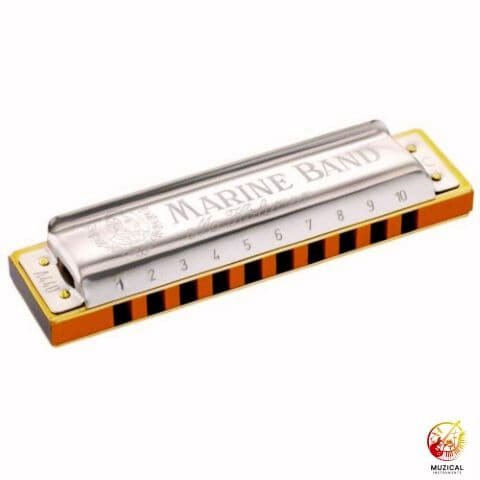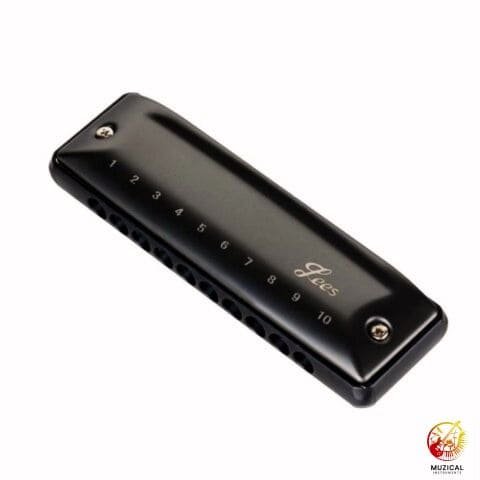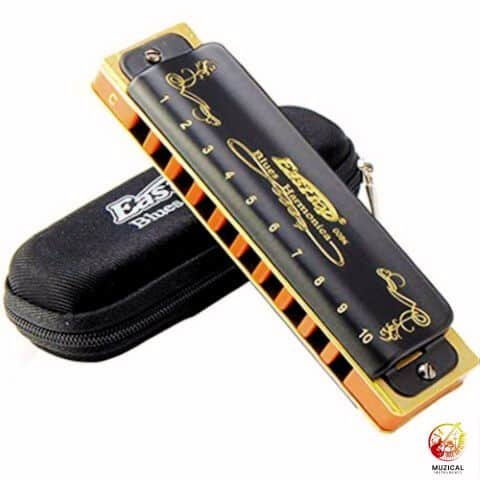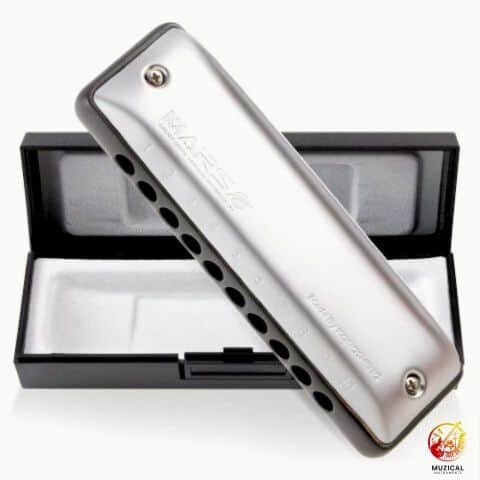Square Holes vs Round Holes Harmonica: Does It Actually Matter?
When you dive into the square holes vs round holes harmonica debate, you’ll find the main difference is the harmonica comb, the central part of the harp that your breath travels through.
For years, traditional harmonicas had square holes because they were cut from wood. But as plastics became common, round holes became easier to make. This one change affects how a harmonica feels, sounds, and plays.
If you’re a harmonica player, you’ve likely wondered if one is truly better than the other, or if it’s all just a matter of taste.
This guide will walk you through everything you need to know, from comfort and tone to which models are best for your style of music, so you can pick the perfect harp for you.
What Makes Square and Round Hole Harps Different?


The biggest difference comes down to how the comb is made. The comb is the middle section of the harmonica with all the little channels for air. It’s sandwiched between two metal reed plates that hold the tiny brass reeds that make the sound.
Historically, combs were carved from wood, like the pearwood comb on the famous Hohner Marine Band. The easiest way to cut channels into a block of wood was to make them square. This is the classic design that powered the blues for generations. It’s a simple and effective way to build a harp.
Then came plastic. With modern injection molding technology, manufacturers could create combs out of plastic or special polymer blends. For these machines, creating perfectly smooth, round holes is fast and very consistent. Brands like Suzuki and even Hohner themselves with their Special 20 model made round holed harmonicas popular.
So, the real difference isn’t just the shape, it’s the material and manufacturing process behind it:
- Square Holes: Usually found on a wood comb. They are cut or milled into the wood.
- Round Holes: Most often found on a plastic comb. They are created using an injection mold.
Think of it like building with LEGOs versus Play Doh. With LEGOs (wood), you work with straight lines and sharp corners. With Play Doh (plastic), you can easily make smooth, rounded shapes. That’s the basic idea behind why we have a square holes vs round holes harmonica choice today.
Pro Tip: A Good Seal Is What Really Matters
While we talk a lot about hole shape, what truly makes a harmonica great is how airtight it is. A harp that doesn’t leak air is easier to play, sounds louder, and lets you bend notes more easily. A well made wood comb that is properly sealed can be just as airtight as a plastic one. When you’re shopping, focus on quality construction, not just the shape of the holes.
Do Square Holes Sound Different Than Round Holes?
This is the big question, and the answer is yes, but it’s subtle. Most of the difference you hear comes from the comb material, not just the hole shape. A harmonica’s tone is a mix of many things: the reeds, the metal cover plates, the comb, and how you play.
Here’s what players generally say:
- Square Holes (Wood Combs): These harps are known for a warm, earthy, and sometimes gritty sound. This is the classic blues harp tone you hear on old records. Is it the square holes causing this? Not really. It’s mostly the wood. Wood is a porous material that absorbs some sound, which cuts down on the super high, sharp frequencies. This leaves you with a darker, warmer sound.
- Round Holes (Plastic Combs): These are often described as having a bright, clear, and loud tone. Plastic isn’t porous like wood, so it doesn’t soak up any of the sound. This means all the frequencies, including the high ones, come through loud and clear. This can give the harmonica a more pure and piercing sound that is great for rock and pop music.
Imagine shouting into a cardboard tube versus a plastic pipe. The cardboard tube will make your voice sound deeper and more muffled. The plastic pipe will make it sound sharp and loud. The hole shape might fine tune the airflow, but the material is doing most of the work to shape the sound. Your own mouth shape, or embouchure, will have an even bigger impact on your tone than anything else.
The Big Debate: Square Holes vs Round Holes Harmonica for Comfort


Comfort is a huge deal, especially if you play for a long time or use techniques like tongue blocking. How the harmonica feels on your lips can make you love it or hate it.
In the world of square holes vs round holes harmonica, round holes are usually the winner for comfort.
- Round Holes: The smooth, curved edges of the mouthpiece on a round holed harmonica are very gentle on the lips and tongue. This makes it easy to slide up and down the harmonica without any scratching or irritation. The Hohner Special 20 is famous for this comfort. Its design is smooth and sleek, which helps reduce lip fatigue. For players who do a lot of tongue techniques, this smooth surface is a huge plus.
- Square Holes: Traditional square holed harps, especially those with unsealed wood combs, can feel a bit sharp. The corners of the holes can feel rough against your lips. Many old school players are used to this and don’t mind it, but it can be a problem for beginners or anyone with sensitive lips. Some players even sand the edges of their wood combs to make them smoother.
Think about running your finger along the edge of a saw versus the edge of a spoon. The spoon is obviously going to feel much nicer. For your sensitive lips, that difference is very noticeable.
| Feature | Square Hole Harmonicas | Round Hole Harmonicas |
|---|---|---|
| Common Comb Material | Wood (Pearwood, Bamboo) | Plastic, Polymer, Alloy |
| Typical Sound | Warm, raspy, traditional | Bright, clear, modern |
| Lip Comfort | Can feel sharp or rough | Usually smooth and very comfortable |
| Best For | Traditional blues, folk | All genres, especially rock and pop |
| Maintenance | Wood can swell if not sealed | Plastic is very durable and easy to clean |
| Famous Models | Hohner Marine Band, Lee Oskar | Hohner Special 20, Suzuki Manji |
Which Is Better for Bending Notes: Square or Round Holes?
When you get to more advanced skills like bending notes and doing overbends, the design of the harmonica becomes really important. Bending notes is what gives the harmonica its soulful, crying sound. Overbends let you play notes that aren’t naturally there, opening up the harp to play any style of music.
Many advanced players find that round holed harmonicas are a bit easier for these techniques. The main reason is that the smooth, round channels help the air flow more evenly.
To hit an overbend, you need a very controlled and stable stream of air. Any leaks or bumpy airflow can make the note squeal or not sound at all. Because round holed harps are often built on very airtight plastic combs, they are usually ready for advanced playing right out of the box.
Does this mean you can’t bend notes on a square holed harmonica? Absolutely not! Blues legends have been bending notes on square holed Marine Bands for a century. However, to get these harps to play their best, especially for overbends, they often need a little work. Players will sand the comb to make it perfectly flat and seal the wood with wax to stop air leaks.
So, it’s not that the square shape itself makes it harder. It’s that the traditional construction that often comes with square holes isn’t always as airtight from the factory. A pro level, customized square holed harp is an amazing instrument. But if you’re buying a stock harmonica, a quality round holed model often gives you a head start on advanced techniques.
Expert Insight: It’s All About Airtightness
Legendary harmonica customizer Joe Filisko once said that making a harmonica play better is all about controlling the air. For bending and overbends, an airtight harmonica is key. It responds faster and requires less effort. Modern harps with plastic combs and round holes are generally more airtight from the factory. But a well maintained wood comb harp can be just as good. The goal is to make sure your breath goes directly to the reed without leaking out the sides.
Which Famous Harmonicas Have Square or Round Holes?
Knowing which models have which design can help you find what you’re looking for. Here’s a quick guide to some of the most popular diatonic harmonicas on the market.
| Harmonica Type | Popular Models | Why People Like Them |
|---|---|---|
| Square Holes | Hohner Marine Band 1896 | The original blues harp. Has that classic, raspy tone from a pearwood comb. |
| Square Holes | Hohner Golden Melody | Has a unique retro look and a plastic comb. The holes are slightly squared. Tuned differently for playing melodies. |
| Square Holes | Lee Oskar Major Diatonic | A real workhorse. Known for being durable with a plastic comb, but with square-ish holes. Easy to get replacement reed plates. |
| Round Holes | Hohner Special 20 | The top recommendation for beginners. Super comfortable plastic comb and mouthpiece. Very airtight and easy to play. |
| Round Holes | Suzuki Manji M-20 | A modern favorite. Has a unique comb made of wood and resin. It’s bright but with some warmth. Great for overbends. |
| Round Holes | Seydel Session Steel | A German-made harp with a comfortable plastic comb and round holes. Famous for its super-durable stainless steel reeds. |
As you can see, some models mix and match. The Lee Oskar, for example, gives you the durability of a plastic comb but with a feel that’s closer to the traditional square hole design. This shows that the square holes vs round holes harmonica choice isn’t always black and white.
Final Thoughts: So, Which Harmonica Should You Get?
In the end, the square holes vs round holes harmonica choice comes down to personal taste. There is no single “best” harmonica, only the one that is best for you and the music you want to play.
If you are a beginner, the answer is easy: start with a round holed harmonica like a Hohner Special 20. It’s comfortable, durable, easy to play, and sounds great. It lets you focus on learning without fighting the instrument.
If you have some experience, think about the sound and feel you want:
- Do you want that classic, gritty blues sound? Go for a traditional square holed Marine Band.
- Do you want maximum comfort, a bright sound, and an easier time with advanced techniques? A round holed Suzuki Manji or Seydel Session Steel would be a great choice.
The best thing you can do is try both. If you can, go to a music shop and just hold them. Feel the difference on your lips. Your personal preference will guide you better than anything you can read online.
Many serious players own both types, choosing the right tool for the right song. The journey of exploring the square holes vs round holes harmonica world is part of the fun of being a musician.
FAQ: Square Holes vs. Round Holes Harmonica
1. What’s the difference between square holes and round holes on a harmonica?
Square holes offer a tighter embouchure seal and sharper note isolation, making them ideal for bending notes and expressive blues phrasing. Round holes feel softer and smoother; you glide more easily across the harp with fewer snags in fast runs or folk melodies.
2. Which hole shape is easier for beginners?
Round holes tend to be more forgiving. They help with smoother airflow and easier navigation across holes great for early stage players mastering diatonic playing or basic chromatic technique.
3. Do hole shapes affect the harmonica’s sound?
Yes. Square hole harps produce a focused, direct tone excellent for solo melodic detail. Round hole models offer a more open, organic resonance that blooms in ensemble settings or folk styles.
4. Is there a difference in comfort or wear between square and round holes?
Round holes are generally more lip friendly, smoother contact, fewer sharp edges. Square holes, with their corners, can be a bit tougher on lips or even facial hair during long playing sessions.
5. Are round or square holes easier to maintain?
Round holes clean more easily wiping across them usually suffices. Square holes may collect moisture or debris in their corners, requiring a soft brush or extra care to keep them in top condition.
6. What do players say about switching between hole types?
Many harpists adapt quickly. For example, one player noted switching from square to round hole harps improved tongue blocking, trills, and warble control even after just a short time.
7. Is one hole shape better for chromatic harmonicas?
It depends. Some chromatic models (like the CX-12) feature round holes and offer comfort and speed. Others (like older Discovery models) use square holes with rounded corners, comfort isn’t sacrificed, and slide mechanics differ.
8. Do hole shapes matter more than reed quality or comb material?
Not necessarily. Some players believe reed responsiveness or comb type plays a bigger role in tone and playability. Hole shape is one part of the equation, impactful, but best considered alongside build and materials.
